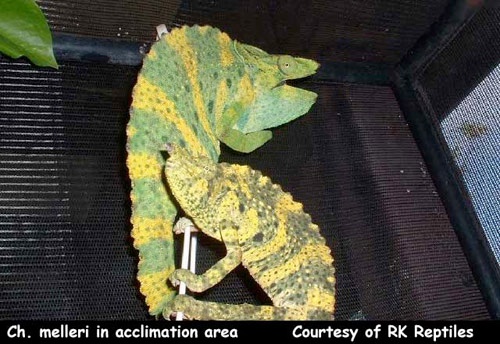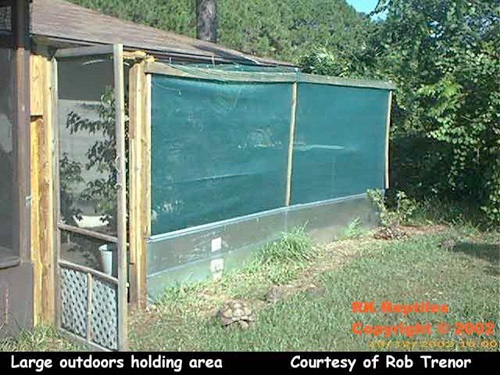



Acclimating Chamaeleo (Trioceros) melleri
By Rob Trenor
Citation:
Trenor, R. (2002). Acclimating Chamaeleo (Trioceros) melleri. Chameleons! Online E-Zine, November 2002. (http://www.chameleonnews.com/02NovTrenor.html)
Acclimating Chamaeleo (Trioceros) melleri
I have worked for many years trying to get a system that allows the wild caught animals the opportunity to adjust to a captive environment and I would like to take this opportunity to stress that wild caught animals are not easy to acclimate and can be costly to acclmiate. I work with many different species from many different countries and one of chameleons I deal with on a regular basis is Chamaeleo melleri from Tanzania.
I import approximately 50 C. melleri per month. When we get them in, I accompany the US Fish & Wildlife for their inspection to ensure the best care possible from the beginning. Once the inspections are done, I always drive them directly to my facility in a temperature-controlled vehicle to ensure they do not get over heated. We usually arrive at my facility at 8pm that evening. Once at my facility they are all housed for the first night in multiple 250-gallon style Reptariums ® (plastic screen cages). They immediately receive about a 45-minute shower in nice warm water that is about 85 degrees. I also immediately offer them food. I offer 3-4 crickets per animal, which enables them to eat but does not give too many items in case they do not eat. Too many uneaten feeder insects will chew and bite the chameleons. These bites can be problematic and become infected and adding more stress for the animals. The next morning after arrival, every animal receives another nice long warm shower to further hydrate them. (C. melleri is a species that seems to always drink a lot of water.)
After they have received the second shower, each animal receives a dose of Nutri Bac DF® as well as their first dosage of Pancur. Nutri Bac is given to help replenish any natural bacteria in the intestinal system that might be depleted during the de-worming process. Panacur is given to kill and eliminate and internal parasites. I dose them on the first dose of Pancur to start the process of eliminating internal parasites. After this treatment they all receive another long warm shower. I use high UVB Fluorescent bulbs on their Reptariums® to give them the required UV rays. I offer them more items of food at that time in case they are hungry. I give them at least 5-6 showers like that every single day when in my care. I house them in the 250 gallon Reptariums® when I am unable to allow them free roam in my outdoor enclosure. My outdoor enclosure measures, 22 feet wide, 17 feet deep, and 12 feet tall in the rear and 9 feet tall in the front. I have an automatic misting system set up that mists the entire enclosure for 30 minutes 6 times per day. I have large live trees in the enclosure as well as some bushes to allow them to feel as comfortable as they can. The entire enclosure is enclosed with green-style shape cloth, and half the roof is covered with black shade cloth. The other half of the roof in plastic screen with 1⁄2" squares. I have tin panels on the bottom of each wall imbedded into the ground about 6-8" to ensure outside animals (i.e. raccoons, opossums, etc.) can not get into the enclosure. I have found that C. melleri acclimate and do so much better in captivity if when they first arrive are given an opportunity to feel comfortable and feel safe in similar conditions as they would find in the wilds of Tanzania. I house them at temperatures of 72-86 degrees F. when they are housed indoors, and house them outside when I know the temperatures will not exceed the high 90's. They do not seem to tolerate higher temperatures very well. They can handle it, but I can tell they are not happy unless the temps are closer to the high 70's. When the temps get to high, the animals become very lethargic and turn very dark, showing that they are unhappy and becoming stressed. When the temps are in the high 70's the animals show nice light green & yellow coloration, are very active in exploring the enclosure and generally show no signs of stress
In my opinion, C. melleri is definitely not a chameleon species that is for beginners. C. Melleri, even when established and healthy, stress very easy and should only be kept by experienced keepers. Unfortunately a lot of the C. melleri that are imported into the US perish because the end purchaser does not follow certain rules with the species.
The biggest killer in C. melleri that I have found is that the owner does not allow the animal a large enough, well-planted enclosure where it can feel safe & comfortable. I would recommend a minimum size cage of at least 6 feet tall and 3 or 4 feet in width and depth. I would recommend the use of a large dense tree in the enclosure to let the animal feel secure
The second reason is the owners usually want to handle the animal. C. melleri do not like being handled at all. The stress of being even handled a little bit is sometimes too much for the animals to over come. Because they are so easily stressed, I always suggest that you handle them as little as possible, just enjoy them in their enclosure as all chameleons should be enjoyed.
C.melleri are in general a highly stressed chameleon in captivity and the importation process is even more stressful for the animals. If captive care is to be attempted everything possible should be done to eliminate as much stress from the animal's life and their acclimation to a captive environment.
My goal is to allow the wonderful species of C. melleri a chance to survive in the US and be enjoyed by many other people without the loss of any animals. I hope more people will understand their beauty and the need for further education on this species and hope that in the future more people will be able to successfully maintain and breed this species in captivity.




Rob Trenor

Rob Trenor feels very lucky to be able to follow his dream. With the support of his wife, Kim, he left his job as an engineer to start RK Reptiles. The company specializes in chameleons. Rob hopes that his enthusiasm will spread and that the spread of solid husbandry information will increase the enjoyment of these special lizards.









Join Our Facebook Page for Updates on New Issues:
© 2002-2014 Chameleonnews.com All rights reserved.
Reproduction in whole or part expressly forbidden without permission from the publisher. For permission, please contact the editor at editor@chameleonnews.com
